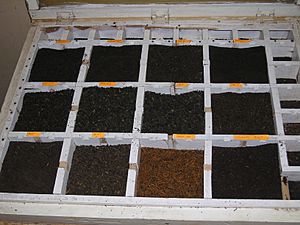Tea blending and additives facts for kids
Tea blending is when different types of tea are mixed together. This creates a new, final tea product. Most tea bags use blended black tea. Blending also happens with teas like Pu-erh. For Pu-erh, leaves from different areas are blended before being pressed.
The main goal of blending is to make a tea with a balanced and consistent taste. This helps to smooth out small differences in tea leaf quality. It also helps with changes that happen from one season to another. A key rule in blending is that every batch must taste the same. This way, you won't notice a difference in flavor when you buy the tea again.
There are three main reasons why tea is blended:
- Making large amounts: Blending helps keep the taste the same for huge batches of tea sold in stores.
- Health benefits: For a long time, people in China and India have blended tea leaves with herbs and spices. They do this for health reasons.
- Adding new flavors: Blending, scenting, or flavoring teas is a popular way to add interesting and complex tastes.
Some teas have extra ingredients or are processed differently from "pure" teas. Tea can easily pick up smells. This can be a problem when moving or storing tea. But it can also be used to make scented teas. Tea can be flavored in large mixing drums. Perfumes, flavorings, or essential oils can be added. Blending and scenting can make tea more interesting. However, sometimes this process is used to hide the poor quality of some teas.
Flavored and Scented Teas
Many teas are still flavored directly. They use flowers, herbs, spices, or even smoke. But teas with special flavors often use added flavorings or perfumes. This is especially true for teas with strong fruit or flower smells. These smells cannot be made with only the original ingredients. Some companies, like Mariage Frères and Kusmi Tea, are famous for their perfumed teas.
The most common scents are jasmine and bergamot oil. Jasmine is often used for light white and green teas. Bergamot oil gives Earl Grey tea its special scent.
This section will focus on teas flavored directly with natural scent materials.
Flowers
Many types of flowers are used to flavor teas. While some teas use real flowers, most flower-scented teas use perfumes or aromas. These are added to boost or replace the use of actual flowers. The most popular flower-scented teas include:
- Jasmine: Jasmine flowers are spread with tea leaves while the tea is oxidizing. Sometimes, a few flowers are left in the tea for decoration. Jasmine is most often used to flavor green teas. This makes jasmine tea. It can also be used with light oolong teas like baozhong tea.
- Osmanthus: In China, osmanthus tea (guì huā chá) is made by mixing dried sweet osmanthus flowers (guì huā) with black or green tea leaves. This is similar to how jasmine tea is made. The flowers are spread with the tea as it oxidizes. Sometimes, some flowers are left in the tea. This flower gives the tea a mild peach flavor. It is the second most popular scented tea in China, after jasmine.
- Rose: Rose flowers are spread with tea leaves while the tea is oxidizing. Sometimes, a few are left in the tea for decoration. In China, roses usually scent black tea. The tea is then called rose congou.
- Chrysanthemum: These flowers are often brewed alone as a chrysanthemum tea. But they are also often mixed with pu-erh tea. This makes chrysanthemum pu-erh.
- Lotus: Vietnamese lotus tea is made by putting green tea leaves inside a lotus flower. The tea absorbs the scent overnight. Another way to make this tea is by baking the tea leaves with the fragrant stamens of the flower many times.
- Orchid: This includes vanilla.
Herbs
- Mint: Maghrebi mint tea, or Moroccan mint tea, is a mix of green teas and any type of mint plant. It is very popular in the Middle East and North Africa's desert areas. You can also find peppermint tea.
- Pandan: Pandan, also called screwpine, is a popular addition to green or black tea. It is used in Malaysia, Indonesia, and the Philippines.
Other Flavorants
- Citrus peel: The most famous tea in this group is Earl Grey tea. It is made by adding citrus or bergamot peel to black teas. Often, an essential oil or perfume blend of the citrus fruit is used instead. Lady Grey tea is different from Earl Grey. It has extra lemon peel and orange peel.
- Rum: Jagertee is a tea that has rum added to it.
- Roasted grain: Genmaicha is a Japanese tea. It has roasted rice added to green tea. People who follow a macrobiotic diet often flavor their tea this way. Wheat and barley are also used to blend with tea.
- Smoke: One type of smoky tea is lapsang souchong. It is made by drying black tea over smoking pine needles. This gives it a strong smoky smell and taste. The best types are not too smoky. They still have a subtle mix of other flavors. Lapsang souchong is found in many Russian Caravan tea blends.
- Spice: Teas like Indian and Middle Eastern masala chai are flavored with sweet spices. These include ginger, cardamom, cinnamon, cassia, black pepper, clove, anise, fennel, Indian bay leaf. Sometimes vanilla, nutmeg, and mace are also added. See also Kahwah.
- Tapioca: Taiwanese bubble tea is flavored with chewy tapioca balls (also called "boba").
See also
 In Spanish: Blend de té para niños
In Spanish: Blend de té para niños




